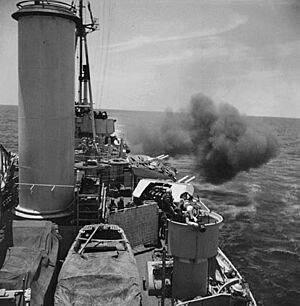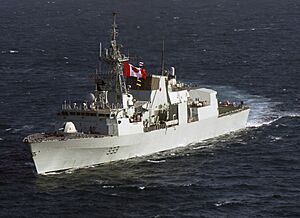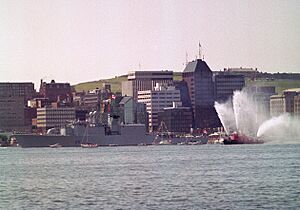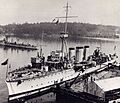History of the Royal Canadian Navy facts for kids
The Royal Canadian Navy (RCN) is Canada's naval force. It was first created in 1910 as the Naval Service of Canada. A year later, King George V officially renamed it the Royal Canadian Navy. The RCN is one of the three main parts of the Canadian Forces. Throughout its history, the RCN played a role in the First World War. It also helped a lot in the Battle of the Atlantic during the Second World War. Later, it was part of NATO's forces during the Cold War. In 1968, the RCN joined with the Canadian Army and the Royal Canadian Air Force to form the unified Canadian Armed Forces. The naval force was called Maritime Command until 2011, when it was renamed the Royal Canadian Navy again.
Contents
In the early 1900s, there was a big discussion in the British Empire about how its different countries, called Dominions, would help with defence. A major part of this talk was about navies, especially because Germany was building up its navy quickly. In Canada, people debated two choices: either Canada could give money and people to the Royal Navy, or it could start its own navy that could help the Royal Navy if needed. After many political talks, Canadian leaders chose to create their own navy.
On March 29, 1909, George Eulas Foster suggested in the House of Commons of Canada that Canada should create a naval service. This idea didn't pass right away. But on January 12, 1910, Prime Minister Sir Wilfrid Laurier brought it back as the Naval Service Bill. This bill became law on May 4, 1910, and was called the Naval Service Act. It created a new government department for the navy.
The act said the navy would have:
- A permanent force (full-time sailors)
- A reserve (sailors called up in emergencies)
- A volunteer reserve (more volunteers for emergencies)
- A naval college for training
The navy was first called the Naval Service of Canada. Rear-Admiral Charles Kingsmill became its first director. On August 29, 1911, King George V approved changing the name to the Royal Canadian Navy.
Training and First Ships
The first naval college opened in Halifax, Nova Scotia, in 1911. It was called the "Royal Naval College of Canada". The college taught naval science, engineering, math, and history. Students could join the British or Canadian navy after graduating. In December 1917, the original college was destroyed in the Halifax Explosion. What was left moved to Royal Military College of Canada in Kingston, Ontario. The college later moved to Esquimalt, British Columbia, in 1919, but it closed in 1922.
To start its new navy, Canada bought two ships from Great Britain. The cruiser HMCS Rainbow was the first ship to join Canada's navy on August 4, 1910. She worked on Canada's west coast, doing fishery patrols and training. Another British cruiser, Niobe, joined the Canadian navy on September 6, 1910. She arrived in Halifax, Nova Scotia, in October 1910.
Challenges and Growth
These early plans faced problems when Prime Minister Laurier lost the 1911 election. The new government, led by Robert Borden, had been against the Naval Service Act. Borden later agreed to pay for three large warships, called dreadnoughts, for Britain. This plan was very expensive and didn't help Canadian industries. The plan was defeated by the Senate in 1913. This left the Royal Canadian Navy with little money, two old cruisers, and no new ships.
Despite these problems, many Canadians still supported a national navy. In May 1914, a volunteer reserve called the Royal Naval Canadian Volunteer Reserve (RNCVR) was formed. It started with 1,200 men and grew a lot during the First World War.
Just before the First World War, the leader of British Columbia bought two submarines (CC-1 and CC-2) from a shipyard in Washington. These submarines were meant for Chile but the deal fell through. On August 7, 1914, the Canadian government bought these submarines, and they joined the RCN.
The World Wars
First World War Efforts
When the First World War started on August 5, 1914, two government ships, CGS Canada (renamed HMCS Canada) and CGS Margaret, immediately joined the navy. They joined Niobe, Rainbow, and the two submarines CC-1 and CC-2, forming a six-ship navy. Many Canadian men chose to join the Royal Navy, but the RCN still grew.

In late 1914, HMCS Rainbow patrolled the west coast of North America. HMCS Niobe patrolled near New York City as part of British forces. Both ships were later taken out of active service. The submarines CC-1 and CC-2 patrolled the Pacific for three years. In 1917, they moved to Halifax, becoming the first warships to go through the Panama Canal flying the RCN's flag. However, they were then declared unfit for service and were scrapped in 1920.
In June 1918, a German U-boat sank the hospital ship HMHS Llandovery Castle. This was the worst Canadian naval disaster of the First World War in terms of lives lost.
In June 1918, the Royal Canadian Naval Air Service (RCNAS) was formed to use flying boats to hunt submarines. It took over a U.S. Navy air station in Nova Scotia. But after the war ended on November 11, 1918, the RCNAS was closed.
Between the Wars
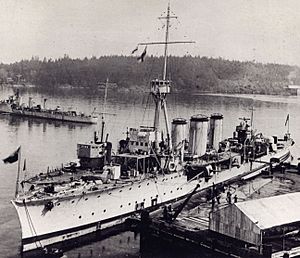
After the First World War, the RCN became much smaller. By 1922, it had only 366 men and had given up its last cruiser. However, it kept two destroyers given by the Royal Navy, HMCS Patriot and HMCS Patrician. These were later replaced by HMCS Champlain and HMCS Vancouver.
In 1923, the Royal Canadian Naval Volunteer Reserve (RCNVR) was created with 1,000 members. Units were set up in many Canadian cities.
In 1931, the RCN got its first ships built specifically for Canada: the destroyers HMCS Saguenay and HMCS Skeena. In 1932, Skeena and Vancouver helped protect British people in El Salvador during a peasant uprising.
Throughout the 1930s, the RCN didn't get much money or equipment. But as countries like Nazi Germany, Italy, and Japan became more aggressive, Canada slowly started to rebuild its navy. It bought two more destroyers, HMCS Ottawa and HMCS Restigouche. By September 1939, when the Second World War began, the RCN still had only six destroyers, five minesweepers, and two small training ships. It had bases in Halifax and Victoria, with about 145 officers and 1,674 men.
Second World War Expansion
The RCN grew a lot during the Second World War. Many larger ships were transferred or bought from the US and British navies. Smaller ships like corvettes and frigates were built in Canada. By the end of the war, Canada had the fourth-largest navy in the world.
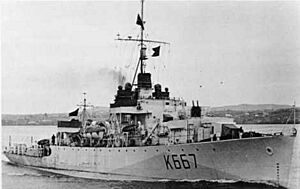
Even though the RCN was sometimes inexperienced early in the war, its sailors, many of whom had never seen the ocean before, did an amazing job. By the end of the Battle of the Atlantic, the RCN was the main navy in the northwest Atlantic Ocean. Under Rear-Admiral Leonard W. Murray, it safely escorted countless convoys and destroyed many German U-boats.
Canadian ships sank 27 U-boats and 42 enemy surface ships. But the biggest success was helping 25,343 merchant ships cross the ocean safely. These ships carried huge amounts of cargo and many Canadian and US soldiers needed for the victory in Europe. Canada lost 24 ships and 1,797 sailors during the war.
As the war against Germany ended, attention turned to Japan. Some RCN ships joined the British Pacific Fleet in late 1944. The RCN also planned to expand its abilities beyond just hunting submarines. The war ended before these plans were fully realized when two nuclear bombs were dropped on Japan.
After the war, the RCN stopped growing. Two aircraft carriers from the Royal Navy, HMCS Warrior and HMCS Magnificent, were transferred to Canada. Most of Canada's wartime ships were put into storage by 1947.
Sailor Protests of 1949
In early 1949, the RCN faced three incidents of sailors protesting.
- On February 26, on the destroyer HMCS Athabaskan in Mexico, more than half the crew locked themselves in their living areas. They refused to come out until the captain listened to their complaints.
- On March 15, on another destroyer, HMCS Crescent in China, 83 junior sailors did a similar protest.
- On March 20, on the aircraft carrier Magnificent in the Caribbean Sea, 32 aircraft handlers briefly refused an order to clean the ship.
In all three cases, the captains handled the situation very carefully. They talked with the sailors and avoided using the word "mutiny," which could have led to serious legal trouble for the sailors.
Defence Minister Brooke Claxton asked Rear-Admiral Rollo Mainguy to investigate. The "Mainguy Report" found that there was no evidence of a plot between the crews. It said the protests were caused by:
- Problems with how sailors were managed.
- No good way for sailors to share small complaints, which led to these protests.
- Frequent changes in ship duties without good explanations.
- A breakdown in the relationship between officers and petty officers.
- A lack of a clear Canadian identity in the Navy.
This last point was very important. It suggested that some officers had old-fashioned British attitudes that didn't fit with Canadian ideas. This led to changes in later years, where the RCN slowly moved away from some British traditions in things like flags and uniforms.
Building for the Cold War
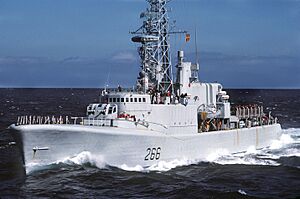
After the Second World War, Canada cut its military spending. But the start of the Cold War and the North Atlantic Treaty Organization (NATO), along with the Korean War, made Canada increase its military spending again. For the RCN, this meant more sailors, fixing up old ships, and building new ones. Canadian destroyers were sent to Korea from 1950 to 1955 to help the United Nations forces. They performed dangerous tasks like bombarding enemy shores.
At the same time, the growing Soviet submarine threat led the RCN to improve its anti-submarine abilities. Many wartime frigates were updated. The RCN also built new classes of anti-submarine destroyer escorts (DDEs). These new ships, like the seven St. Laurent-class DDEs, had special designs to handle rough seas and prevent ice buildup. These were followed by the Restigouche, Mackenzie, and Annapolis classes. By the early 1960s, most of the RCN's Second World War ships were retired.
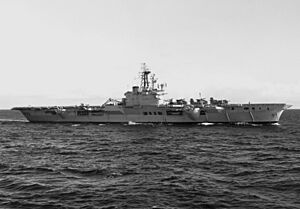
To make its ships better at hunting submarines, the RCN was a pioneer in using large helicopters on small ships like destroyers. They invented the "Bear Trap," a system that helped pull a helicopter onto a ship's deck even in rough weather. The St. Laurent-class DDEs were updated to carry CH-124 Sea King anti-submarine helicopters. The RCN also helped develop new sonar technology, like variable depth sonar (VDS), which could detect submarines from much farther away. These improvements made the RCN a key player in anti-submarine warfare for NATO.
The RCN also improved its aviation. While Canadians had served on British aircraft carriers during the war, Canada got its own carrier, HMCS Warrior, in 1946. She was replaced by HMCS Magnificent in 1948, and then by the more modern HMCS Bonaventure in 1957. The RCN also used air stations to operate fighter jets and anti-submarine aircraft.
Unification and Modernization
Joining the Canadian Forces
On February 1, 1968, the Royal Canadian Navy, along with the Royal Canadian Air Force and the Canadian Army, became part of the new, unified Canadian Forces. The naval forces were renamed Canadian Forces Maritime Command (MARCOM).
For many naval personnel, this change was difficult. They had to give up their old flags, and even wear army-style green uniforms and ranks instead of their unique naval ones. Many officers, including Rear-Admiral William Landymore, were upset by these changes. Landymore was even fired for trying to keep naval traditions.
MARCOM was formed on June 7, 1965, and the Royal Canadian Navy officially stopped being a separate service on February 1, 1968. Canadian sailors wore a common "CF green" uniform. In the 1970s, MARCOM returned to naval-based ranks. In 1985, the Canadian Armed Forces brought back distinct uniforms for each branch, and the new naval uniform looked similar to the old RCN one, but with some differences.
The 1968 unification was the first time a modern military combined its sea, land, and air forces under one command. The navy's air units also became part of the Maritime Air Group, and later the Canadian Forces Air Command (AIRCOM) in 1975.
Changes to the Fleet
After 1968, MARCOM made several changes to its ships. The last aircraft carrier, HMCS Bonaventure, was old and was taken out of service in the early 1970s. It was decided not to replace her, and instead focus on traditional warships.
In 1972, four new Iroquois-class destroyers, also called the Tribal class, were added to the fleet. By the mid-1970s, the navy planned for a new class of frigates to replace older ships. This design became the Canadian Patrol Frigate (CPF), which later became the Halifax-class frigate class. Twelve of these frigates were built from the late 1980s to 1990s.
In the mid-1980s, the four Iroquois-class destroyers were updated to become air-defence destroyers. They were the first non-US ships to carry the Standard SM-2 anti-aircraft missile.
The 1990s saw the addition of the Kingston-class coastal defence vessels. These ships improved MARCOM's ability to clear mines and survey routes. Naval reservists operate the Kingston class, and they are also used for training.
On October 23, 1969, HMCS Kootenay had the worst peacetime accident in RCN history. During engine tests, a gearbox exploded, killing 9 crew members and injuring at least 53 others.
MARCOM ships participate in NATO forces in the Atlantic and in exercises off Norway. They patrol the North Atlantic and Pacific oceans to protect Canadian interests.
In 1990, MARCOM quickly sent the destroyer escort HMCS Terra Nova, the destroyer HMCS Athabaskan, and the supply ship HMCS Protecteur to the Persian Gulf for Operation Desert Shield and Operation Desert Storm. The Canadian Navy led the coalition's sea support operations.
In the mid-to-late 1990s, MARCOM ships were part of a NATO task force patrolling the Adriatic Sea near the former Yugoslavia. As part of Operation Apollo, Canada's effort against terrorism, 20 MARCOM ships have patrolled the Arabian Sea in recent years.
In 1995, Canada had a small disagreement with some European countries over fishing rights, known as the Turbot War.
On May 4, 2010, politicians suggested renaming Maritime Command back to the Canadian Navy to celebrate its 100th birthday. As of May 2010, the special "executive curl" on officers' uniforms was brought back.
In June 2010, the Royal Canadian Navy celebrated its 100th anniversary in Victoria, British Columbia, with a large fleet review. Many ships from Canada, France, Japan, Australia, New Zealand, and the United States participated. Another celebration took place in Halifax, Nova Scotia, with 18 vessels and a review by Queen Elizabeth II and Prime Minister Stephen Harper.
In 2010, SONAR, a Newfoundland dog and the navy's mascot, was "recruited" into the navy as part of the centennial celebrations.
On May 12, 2011, HMCS Charlottetown came under fire from small boats off the coast of Libya. This was the first time a Canadian naval ship had been attacked by an enemy since the Korean War.
What many called the modern Canadian Navy was known as Canadian Forces Maritime Command (MARCOM) from 1968 to 2011. Even though the Royal Canadian Navy officially stopped being a separate service in 1968, MARCOM continued many of its traditions. Canadian naval ships still use the prefix HMCS, which stands for "Her/His Majesty's Canadian Ship/Submarine".
On December 14, 2010, the Canadian Senate asked the government to change the name of Canada's naval force back to include the word "navy." On August 16, 2011, the government announced that Maritime Command would officially regain its former name, the Royal Canadian Navy.
Flags and Ensigns
On March 3, 1911, the RCN was allowed to use the White Ensign, which was its main flag for 54 years. At the same time, the Canadian Blue Ensign became the navy's jack (a flag flown at the front of the ship when docked). Because the White Ensign was the same as the British Royal Navy's flag, Canadian ships often painted a green maple leaf on their funnels to show they were Canadian.
In the 1950s, as British and Canadian foreign policies became different, having the same flag as the Royal Navy was less ideal. In 1961, the RCN started flying the Canadian Red Ensign from the masthead. On February 15, 1965, all these old flags were replaced by the new National Flag of Canada, the Maple Leaf flag.
Aircraft Roundels
After the Second World War, Canadian military aircraft started using roundels (circular symbols) with a red maple leaf. The RCN's aircraft used a roundel based on the sugar maple leaf. In 1965, both the RCAF and RCN adopted the same roundel, which featured the stylized leaf from Canada's new flag.
Since 1975, the RCN has not had its own aircraft roundel because all aircraft used on ships are operated by the Royal Canadian Air Force.
The Commander of the Royal Canadian Navy is the main leader of the navy. This role has had different names over the years. From 1910 to 1928, it was called the Director of the Naval Service. From 1928 to 1964, it was the Chief of the Naval Staff. When the Canadian Forces were unified in 1968, the naval leader was called the Commander of Maritime Command until 1997, and then the Chief of the Maritime Staff until 2011. In 2011, when Maritime Command was renamed the Royal Canadian Navy, the leader's title became Commander of the Royal Canadian Navy.
The history of the Royal Canadian Navy is kept alive and displayed in several museums. These include the Maritime Command Museum in Halifax, the Canadian War Museum, the Naval Museum of Alberta, and the The Canadian Forces Base Esquimalt Naval and Military Museum. Several RCN ships have been preserved, such as the corvette HMCS Sackville, which serves as Canada's Naval Memorial. Also preserved are the destroyer HMCS Haida and the auxiliary patrol ship HMCS/CSS Acadia, which served in both the First and Second World Wars.
Images for kids
-
The light cruiser HMCS Aurora was decommissioned in 1922, along with a number of other ships as the RCN scaled-back after the First World War.
See also
- Bibliography of Canadian military history
- List of aircraft of the Royal Canadian Navy
- List of current ships of the Royal Canadian Navy
- List of Royal Canadian Navy bases (1911–1968)
- List of ships of the Royal Canadian Navy
- Provincial Marine
- Uniforms of the Royal Canadian Navy




